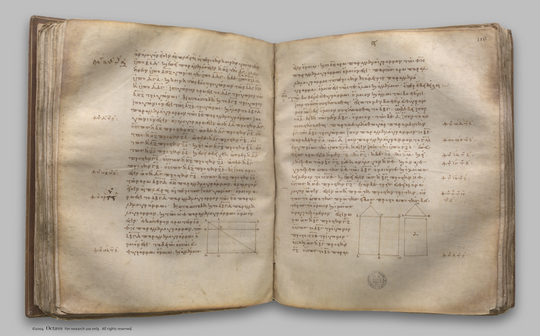index prev next | digilib folio 114

To construct one and the same figure similar to a given rectilineal figure and equal to another given rectilineal figure.
| Τῷ δοθέντι εὐθυγράμμῳ ὅμοιον καὶ ἄλλῳ τῷ δοθέντι ἴσον τὸ αὐτὸ συστήσασθαι. Ἔστω τὸ μὲν δοθὲν εὐθύγραμμον, ᾧ δεῖ ὅμοιον συστήσασθαι, τὸ ΑΒΓ, ᾧ δὲ δεῖ ἴσον, τὸ Δ: δεῖ δὴ τῷ μὲν ΑΒΓ ὅμοιον, τῷ δὲ Δ ἴσον τὸ αὐτὸ συστήσασθαι. Παραβεβλήσθω γὰρ παρὰ μὲν τὴν ΒΓ τῷ ΑΒΓ τριγώνῳ ἴσον παραλληλόγραμμον τὸ ΒΕ, παρὰ δὲ τὴν ΓΕ τῷ Δ ἴσον παραλληλόγραμμον τὸ ΓΜ ἐν γωνίᾳ τῇ ὑπὸ ΖΓΕ, ἥ ἐστιν ἴση τῇ ὑπὸ ΓΒΛ. ἐπ' εὐθείας ἄρα ἐστὶν ἡ μὲν ΒΓ τῇ ΓΖ, ἡ δὲ ΛΕ τῇ ΕΜ. καὶ εἰλήφθω τῶν ΒΓ, ΓΖ μέση ἀνάλογον ἡ ΗΘ, καὶ ἀναγεγράφθω ἀπὸ τῆς ΗΘ τῷ ΑΒΓ ὅμοιόν τε καὶ ὁμοίως κείμενον τὸ ΚΗΘ. Καὶ ἐπεί ἐστιν ὡς ἡ ΒΓ πρὸς τὴν ΗΘ, οὕτως ἡ ΗΘ πρὸς τὴν ΓΖ, ἐὰν δὲ τρεῖς εὐθεῖαι ἀνάλογον ὦσιν, ἔστιν ὡς ἡ πρώτη πρὸς τὴν τρίτην, οὕτως τὸ ἀπὸ τῆς πρώτης εἶδος πρὸς τὸ ἀπὸ τῆς δευτέρας τὸ ὅμοιον καὶ ὁμοίως ἀναγραφόμενον, ἔστιν ἄρα ὡς ἡ ΒΓ πρὸς τὴν ΓΖ, οὕτως τὸ ΑΒΓ τρίγωνον πρὸς τὸ ΚΗΘ τρίγωνον. ἀλλὰ καὶ ὡς ἡ ΒΓ πρὸς τὴν ΓΖ, οὕτως τὸ ΒΕ παραλληλόγραμμον πρὸς τὸ ΕΖ παραλληλόγραμμον. καὶ ὡς ἄρα τὸ ΑΒΓ τρίγωνον πρὸς τὸ ΚΗΘ τρίγωνον, οὕτως τὸ ΒΕ παραλληλόγραμμον πρὸς τὸ ΕΖ παραλληλόγραμμον: ἐναλλὰξ ἄρα ὡς τὸ ΑΒΓ τρίγωνον πρὸς τὸ ΒΕ παραλληλόγραμμον, οὕτως τὸ ΚΗΘ τρίγωνον πρὸς τὸ ΕΖ παραλληλόγραμμον. ἴσον δὲ τὸ ΑΒΓ τρίγωνον τῷ ΒΕ παραλληλογράμμῳ: ἴσον ἄρα καὶ τὸ ΚΗΘ τρίγωνον τῷ ΕΖ παραλληλογράμμῳ. ἀλλὰ τὸ ΕΖ παραλληλόγραμμον τῷ Δ ἐστιν ἴσον: καὶ τὸ ΚΗΘ ἄρα τῷ Δ ἐστιν ἴσον. ἔστι δὲ τὸ ΚΗΘ καὶ τῷ ΑΒΓ ὅμοιον. Τῷ ἄρα δοθέντι εὐθυγράμμῳ τῷ ΑΒΓ ὅμοιον καὶ ἄλλῳ τῷ δοθέντι τῷ Δ ἴσον τὸ αὐτὸ συνέσταται τὸ ΚΗΘ: ὅπερ ἔδει ποιῆσαι. | To construct one and the same figure similar to a given rectilineal figure and equal to another given rectilineal figure. Let ABC be the given rectilineal figure to which the figure to be constructed must be similar, and D that to which it must be equal; thus it is required to construct one and the same figure similar to ABC and equal to D. Let there be applied to BC the parallelogram BE equal to the triangle ABC [I. 44], and to CE the parallelogram CM equal to D in the angle FCE which is equal to the angle CBL. [I. 45] Therefore BC is in a straight line with CF, and LE with EM. Now let GH be taken a mean proportional to BC, CF [VI. 13], and on GH let KGH be described similar and similarly situated to ABC. [VI. 18] Then, since, as BC is to GH, so is GH to CF, and, if three straight lines be proportional, as the first is to the third, so is the figure on the first to the similar and similarly situated figure described on the second, [VI. 19, Por.] therefore, as BC is to CF, so is the triangle ABC to the triangle KGH. But, as BC is to CF, so also is the parallelogram BE to the parallelogram EF. [VI. 1] Therefore also, as the triangle ABC is to the triangle KGH, so is the parallelogram BE to the parallelogram EF; therefore, alternately, as the triangle ABC is to the parallelogram BE, so is the triangle KGH to the parallelogram EF. [V. 16] But the triangle ABC is equal to the parallelogram BE; therefore the triangle KGH is also equal to the parallelogram EF. But the parallelogram EF is equal to D; therefore KGH is also equal to D. And KGH is also similar to ABC. |